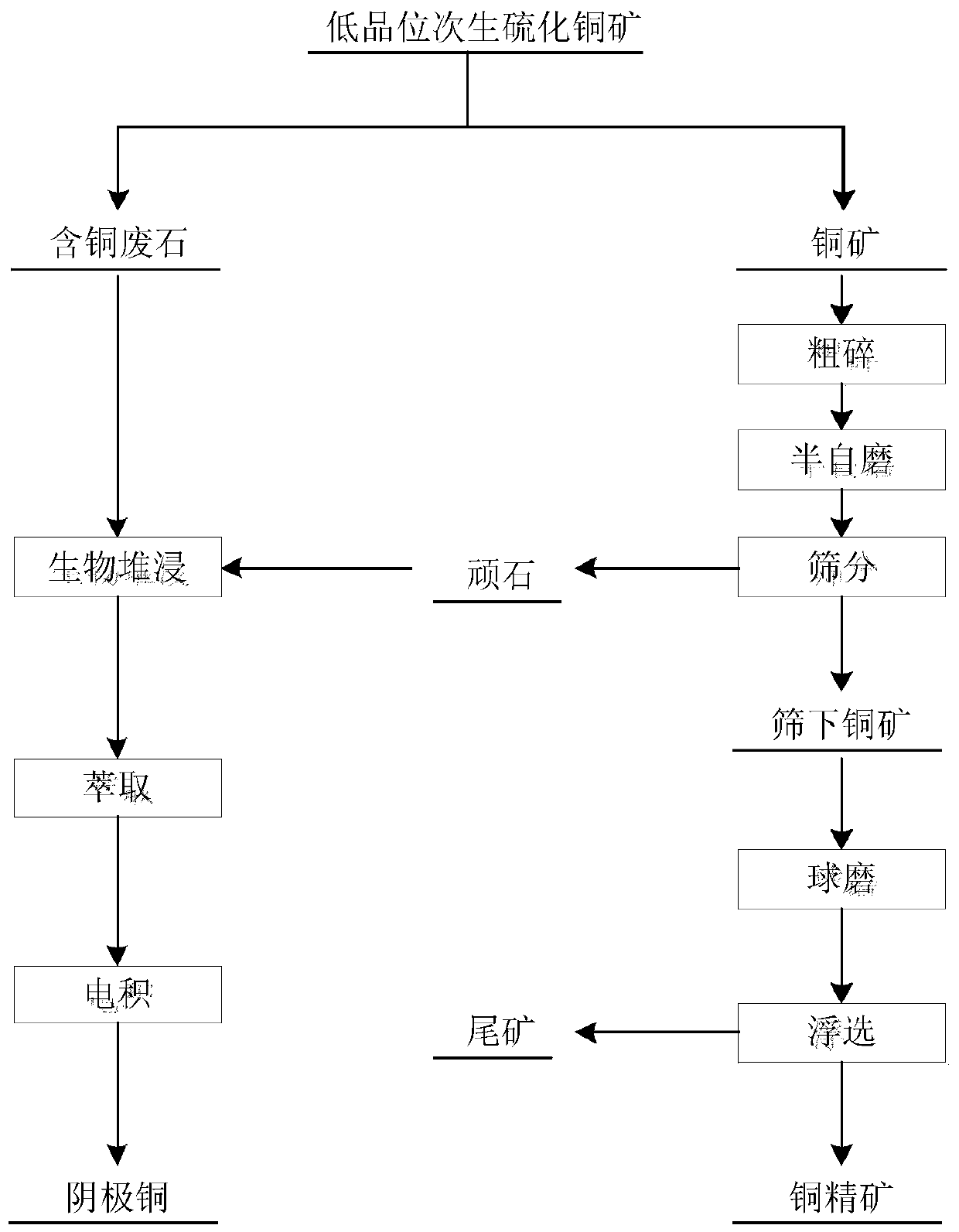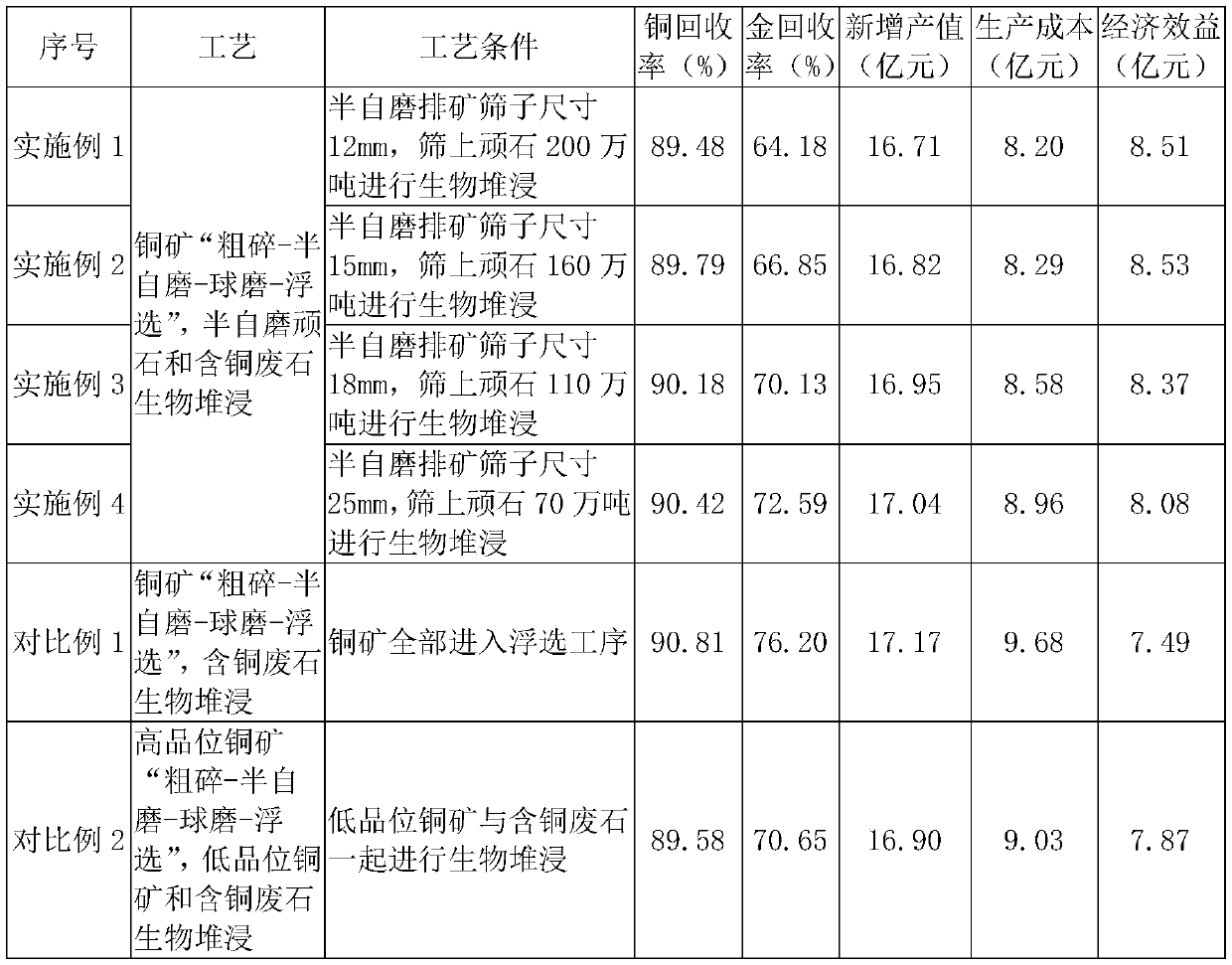Method for efficiently recovering copper from low-grade secondary copper sulfide ore
A low-grade copper sulfide ore technology, applied in the direction of process efficiency improvement, photographic technology, instruments, etc., can solve the problems of inability to achieve high efficiency, economic recovery, ineffective grinding cost, and limited ore processing capacity, etc. Achieve the effect of avoiding difficult and orderly collection, remarkable ecological benefits, and good environmental protection effects
- Summary
- Abstract
- Description
- Claims
- Application Information
AI Technical Summary
Problems solved by technology
Method used
Image
Examples
Embodiment 1
[0033] A secondary copper sulfide mine mines 8 million tons of ore each year (average copper grade 0.40%, gold grade 0.11g / t), and produces 2 million tons of copper-bearing waste rock (average copper grade 0.13%, gold grade 0.05g / t) ). The copper ore is firstly crushed, semi-autogenously ground, and the semi-autogenously ground ore is screened with a 12mm sieve to obtain 6 million tons of -12mm copper ore (average copper grade 0.48%, gold grade 0.123g / t) and 2 million tons of stubborn stone (average copper grade 0.16%, gold grade 0.07g / t). The -12mm copper ore was ball milled and treated by flotation to obtain 119,000 tons of copper concentrate (average copper grade 22.50%, gold grade 5.28g / t). The stubborn rock and copper-containing waste rock were mixed and then bioheap leached, and the leachate was treated by the "extraction-electrodeposition" process to obtain 4,176 tons of cathode copper. The comprehensive recovery rate of copper is 89.48%, and the comprehensive recover...
Embodiment 2
[0035] A secondary copper sulfide mine mines 8 million tons of ore each year (average copper grade 0.40%, gold grade 0.11g / t), and produces 2 million tons of copper-bearing waste rock (average copper grade 0.13%, gold grade 0.05g / t) ). The copper ore is firstly crushed and semi-autogenously ground, and the semi-autogenously ground ore is screened with a 15mm sieve to obtain 6.4 million tons of -15mm copper ore (average copper grade 0.46%, gold grade 0.121g / t) and 1.6 million tons of stubborn stone (average copper grade 0.15%, gold grade 0.068g / t). The -15mm copper ore was ball milled and treated by flotation to obtain 124,400 tons of copper concentrate (average copper grade 22.10%, gold grade 5.27g / t). The stubborn rock and copper-containing waste rock were mixed and then bioheap leached. The leachate was treated by the "extraction-electrodeposition" process to obtain 3575.50 tons of cathode copper. The comprehensive recovery rate of copper is 89.79%, and the comprehensive r...
Embodiment 3
[0037] A secondary copper sulfide mine mines 8 million tons of ore each year (average copper grade 0.40%, gold grade 0.11g / t), and produces 2 million tons of copper-bearing waste rock (average copper grade 0.13%, gold grade 0.05g / t) ). The copper ore is firstly crushed, semi-autogenously ground, and the semi-autogenously ground ore is screened with a sieve with a size of 18mm to obtain 6.9 million tons of -18mm copper ore (average copper grade 0.44%, gold grade 0.117g / t) and 1.1 million tons of stubborn stone (average copper grade 0.14%, gold grade 0.065g / t). The -18mm copper ore was ball milled and treated by flotation to obtain 129,600 tons of copper concentrate (average copper grade 21.80%, gold grade 5.30g / t). The obstinate rock and copper-containing waste rock were mixed and then bioheap leached, and the leachate was treated by the "extraction-electrodeposition" process to obtain 2,948.09 tons of cathode copper. The comprehensive recovery rate of copper is 90.18%, and t...
PUM
 Login to View More
Login to View More Abstract
Description
Claims
Application Information
 Login to View More
Login to View More - R&D
- Intellectual Property
- Life Sciences
- Materials
- Tech Scout
- Unparalleled Data Quality
- Higher Quality Content
- 60% Fewer Hallucinations
Browse by: Latest US Patents, China's latest patents, Technical Efficacy Thesaurus, Application Domain, Technology Topic, Popular Technical Reports.
© 2025 PatSnap. All rights reserved.Legal|Privacy policy|Modern Slavery Act Transparency Statement|Sitemap|About US| Contact US: help@patsnap.com



